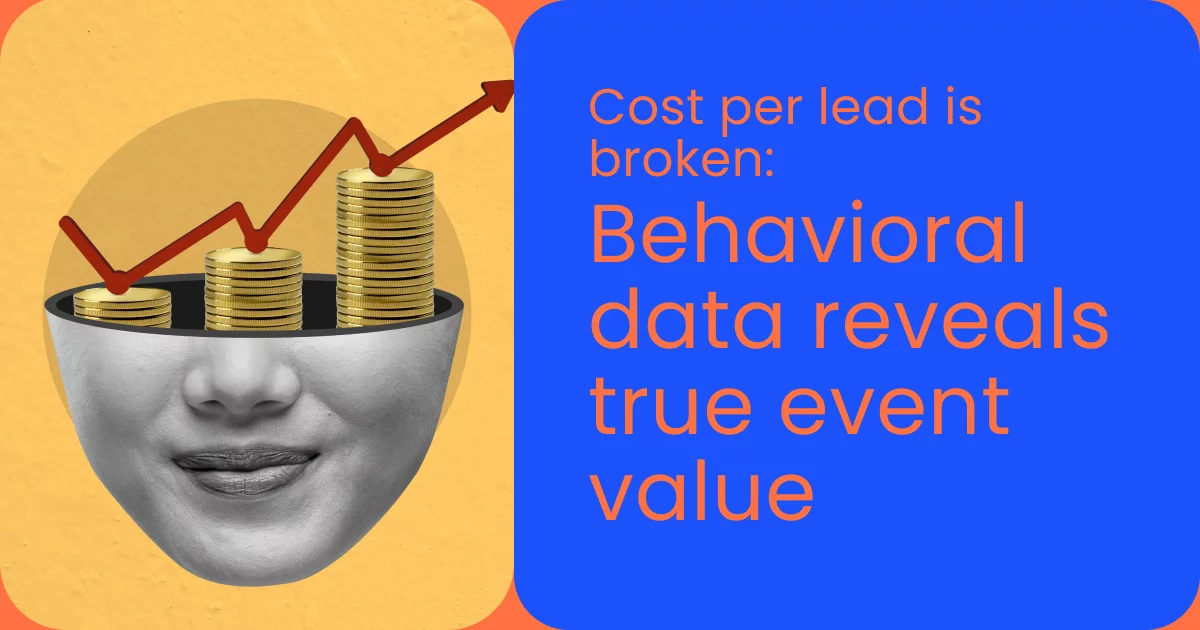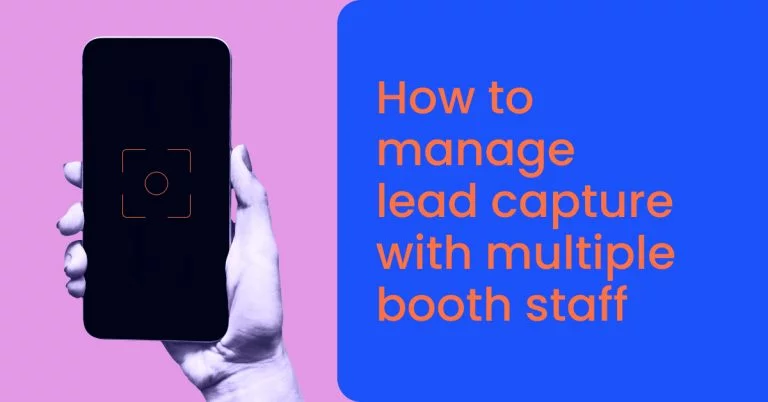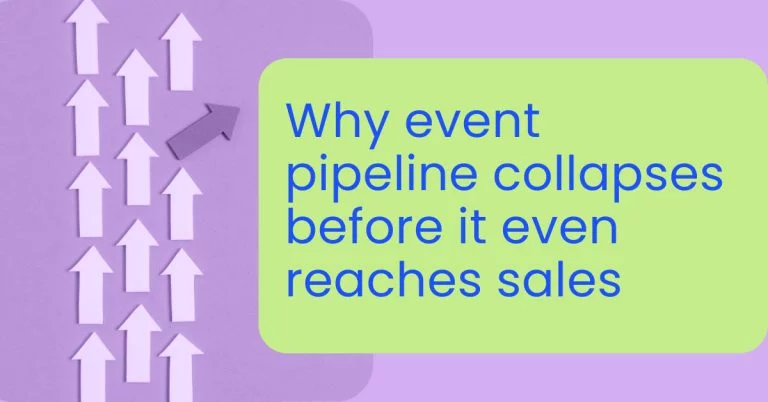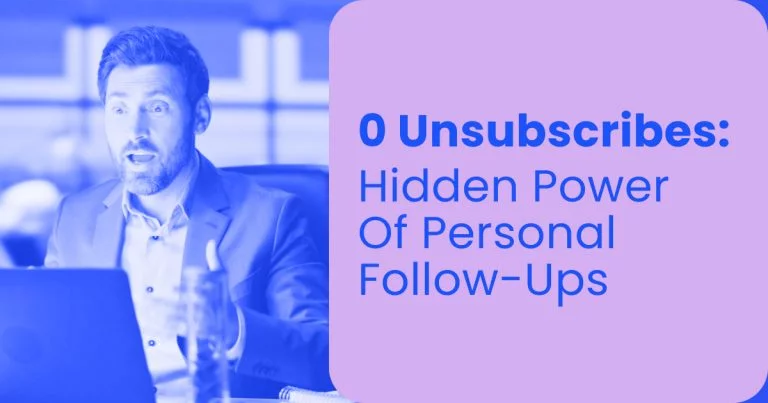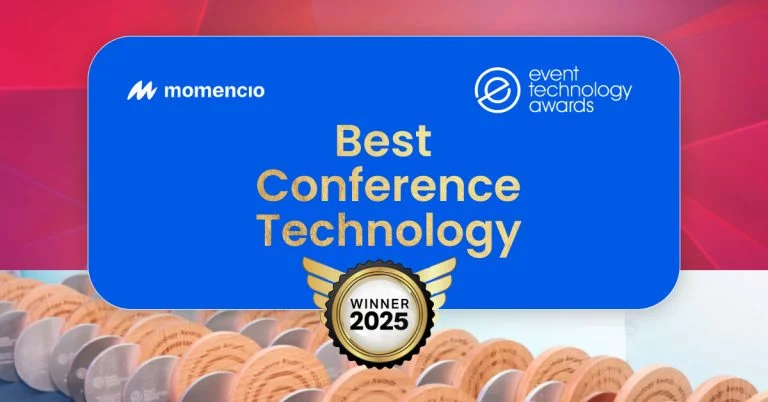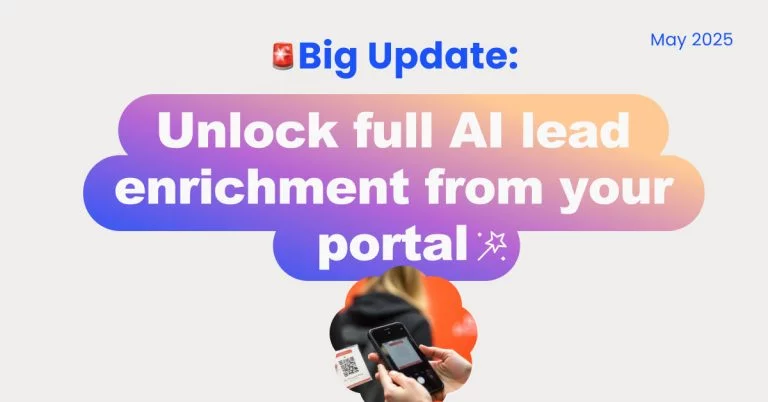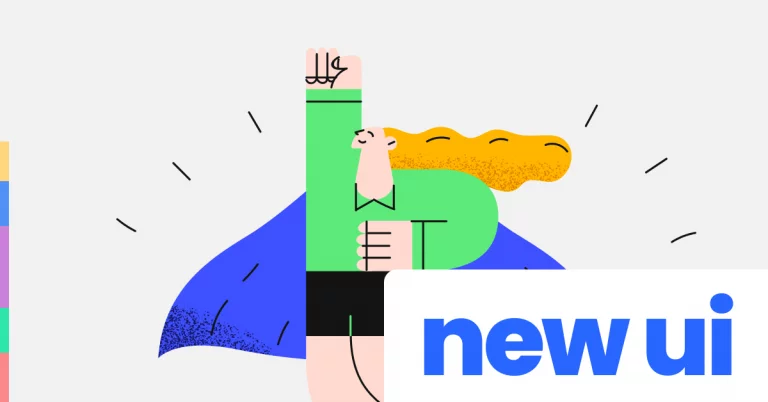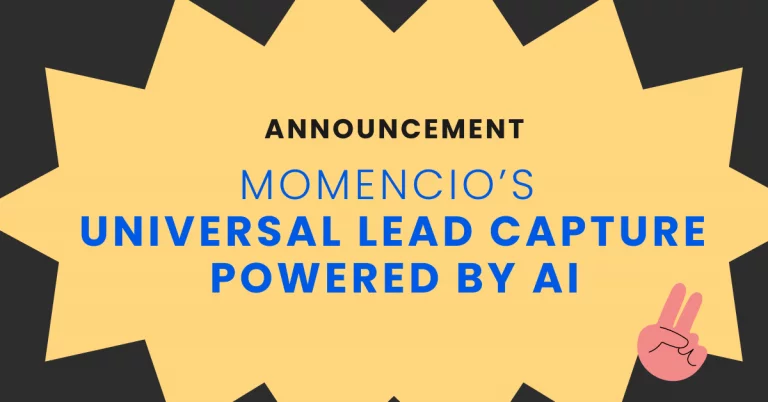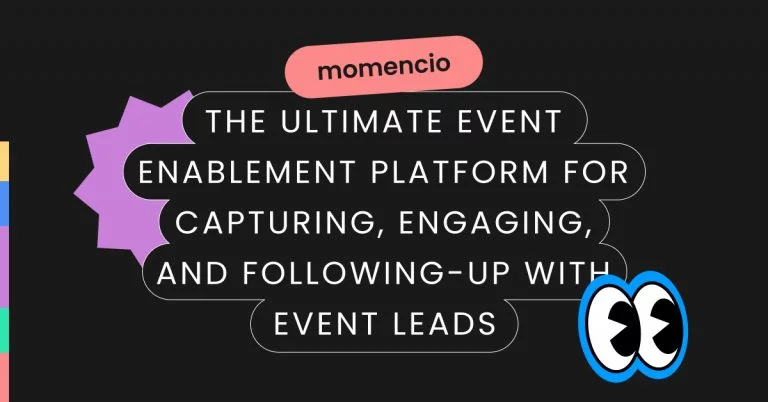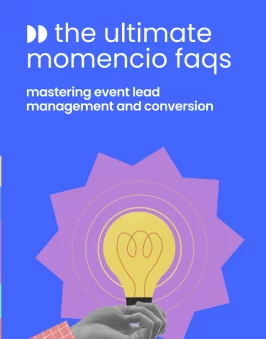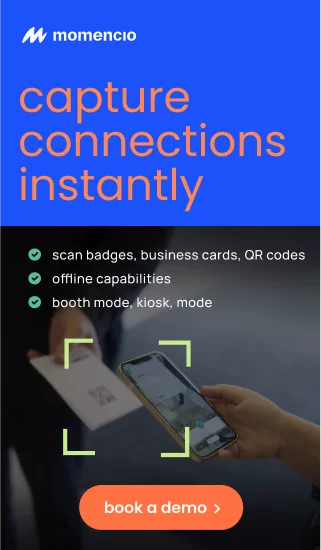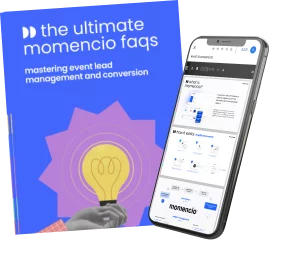Quick scan: why this post matters
Cost per lead (CPL) used to be a tidy metric. Divide your total spend by total scans, and you’ve got a number to show the CFO. But field marketers and event teams know the truth: that number’s often meaningless.
Why? Because not every “lead” is created equal.
At a recent B2B software summit, the average CPL exceeded $237. That’s for each scanned badge, not for each conversation, qualified opportunity, or actual pipeline contributor. And yet, only 32% of marketers say they’re confident in how they measure event ROI.
The disconnect is real. Booth reps juggle hundreds of interactions across noisy show floors. Sales teams chase down contacts with no idea who actually showed interest. Meanwhile, marketing is stuck defending CPL targets that don’t reflect reality.
This post is here to help you shift from “cost per name” to “value per behavior.” Because when you understand what a lead did, not just who they were, the real event ROI starts to reveal itself.
TL;DR
Badge scans are cheap. Buyer attention is not. If you’re still measuring event ROI with cost per lead, you’re optimizing for the wrong outcome. Start measuring how much time your prospects chose to spend with your brand. That’s what moves pipeline. That’s what closes deals. And with tools like momencio, you can track it effortlessly — down to the minute, down to the person, across every event.
The CPL problem in plain sight
Let’s break down how most companies calculate cost per lead:
CPL = Total event spend ÷ Total number of leads captured
Simple. Too simple.
Because here’s what that “lead” might actually be:
- A vendor from the booth next door who scanned for your giveaway
- An intern tagging along with their boss
- A student collecting branded merch for a side hustle on eBay
Sound familiar?
Field marketers and reps know this drill. You hit your scan targets. The numbers look decent. But then the follow-up emails get zero replies. Sales complains the leads are junk. And your post-show wrap deck has more questions than answers.
Here’s what you might be asking:
- “Is a $300 CPL normal for my vertical, or am I being fleeced?”
- “How many of these leads had actual buying power?”
- “Why do my best booth conversations never seem to show up in the CRM?”
CPL gives you volume. But it hides the thing that actually drives pipeline: quality. And that’s where behavioral data steps in.
Next up: let’s unpack what that really means — and why it changes everything.
Defining behavioral data (and why it fixes the blind spots)
At every event, you’re surrounded by people. Some are curious. Some are bored. A few are ready to buy. Yet when the show’s over, you’re handed a spreadsheet filled with names and companies — but nothing that tells you what those people actually did.
That’s where behavioral data comes in.
Behavioral data is the missing layer. It doesn’t just tell you who visited your booth. It shows you how they engaged — what they gravitated toward, how long they stuck around, what they asked, what they clicked, and what they ignored.
At a live event, that data includes:
- Time spent at specific demo stations or product areas
- The sequence and duration of interactions
- Questions asked during conversations
- Digital content they scanned or opened
- Whether they came back for a second visit (huge signal!)
- What follow-up content they actually engaged with post-event
This isn’t just fluff. These are intent signals — live, in-the-moment indicators of interest, urgency, and buying readiness.
Now contrast this with what most event CRMs track today:
- Name
- Title
- Company
- Lead source
- Maybe a checkbox that says “interested in follow-up”
That’s demographic data, and it’s static. It doesn’t tell you if a CMO was passively browsing or if an end user was practically begging for a solution.
Why behavioral data matters more
Demographic scoring — ranking leads based on job title, company size, or vertical — assumes that the right type of person is also the most ready to buy. But events don’t work like that.
An entry-level engineer who spends ten minutes grilling your AE at the booth might be a far better lead than a VP who grabs a coffee and leaves.
Behavioral intent flips the scoring model. It says: Let’s stop assuming. Let’s start watching.
Here’s a simple analogy:
Demographic data is the RSVP list.
Behavioral data is watching who actually danced.
A common question: “Isn’t this creepy or too complex?”
Not at all. When done right, behavioral tracking is:
- Privacy-safe (no facial recognition or creepy surveillance — just activity-based logging)
- Seamless (captured passively through your mobile lead capture app or interactive screens)
- Faster than writing manual notes or relying on reps to remember who was “hot”
Tools like momencio are built for this. Every lead interaction — from dwell time on a demo to the specific content sent post-meeting — gets logged automatically. Your reps don’t have to slow down. And your marketers don’t have to guess who was genuinely engaged.
In short: behavioral data makes invisible intent, visible.
And once you can see it, you can finally act on it.
What top performers track on the show floor (and how it changes pipeline outcomes)
Behavioral data isn’t about “data for data’s sake.” It’s about picking the right signals — those that correlate with real buying behavior — and making them actionable.
Let’s break it down. Here are the key behavioral signals that elite field teams track at events, what those signals actually tell you, and how you can capture them in real time using tools like momencio.
| Behavioral signal | What it reveals | How to capture it (Practically) |
| Time spent at demo station | Higher time = higher curiosity or active problem-solving mindset. Less time = casual interest. | Auto-tracked by momencio’s mobile app. Each rep interaction logs duration per lead badge. Set thresholds (e.g., >3 minutes = qualified). |
| Return booth visits | Signals urgency or multiple stakeholders. Repeat visits often = intent validation before buying conversation. | momencio auto-detects re-scans and can timestamp visits. Reps get nudged when a visitor returns. |
| Depth of conversation (tags or notes) | A lead who dives into pricing, implementation, or integration questions is far closer to decision than one who asks, “What do you guys do?” | Use one-tap tags like “Asked pricing,” “Mentioned pain point,” “Technical deep dive.” Train reps pre-event to log with shorthand or voice-to-text notes. |
| Content engagement post-event (email clicks, downloads) | Strong post-show engagement within 24–48 hours = hot lead. They’re doing homework, possibly looping in others. | momencio tracks content sent per lead, then matches that to engagement (open, click, re-open). Intent score auto-updates in dashboard. |
| Session attendance / booth-to-session crossover | Attending a product-focused session after visiting the booth shows a move down the funnel. | momencio can tag booth visitors who scan into linked sessions. Use this to prioritize booth leads who also show session behavior. |
| Poll/quiz/survey responses on booth iPad | Helps qualify by use case. A marketer selecting “Lead scoring automation” tells you more than their job title ever could. | momencio enables pre-built interactive forms or polls. Responses sync back to the lead profile, enriching the behavioral map. |
| Asset viewed or shared at booth (video, deck, spec sheet) | Content preference reveals buying stage. A case study = problem-solution interest. A technical doc = late-stage evaluation. | Interactive booth tablets or rep-triggered sends in momencio log which assets are viewed/sent and how long they’re opened. |
Real-life: Two leads, same title — wildly different signals
Let’s say you meet two Marketing Directors.
- Director A scans at your booth, grabs a cookie, nods politely during your intro, and leaves after 30 seconds. No follow-up activity.
- Director B walks in with a problem statement (“We’re struggling to unify lead data”), spends 5 minutes at your product demo, requests a pricing deck, and opens that deck later the same night.
CPL tells you they’re equal.
Behavioral data tells you Director B is worth 10x more.
And here’s the kicker: if your post-event lead list doesn’t weight these behaviors — if your CRM just dumps names into nurture emails — then you’re leaving intent and revenue on the table.
The mindset shift: From lead count to context-rich engagement
When your event follow-up starts with, “You stopped by our booth…” you’re playing the same game as every other vendor.
But when you follow up with, “I noticed you spent time on the lead scoring demo and viewed our integration checklist — let’s pick up from there,” you’re no longer a vendor. You’re a partner who’s been paying attention.
Tools like momencio let you build this visibility without adding rep burden. Every interaction — time, content, comments, revisit patterns — gets scored, logged, and visualized. It turns chaotic booth activity into a clear signal of who’s ready for sales, who needs nurture, and who just came for the socks.
Why it’s time to replace “Cost per Lead” with “Cost per Engaged Minute”
CPL is seductive because it’s simple.
But here’s the hard truth: simplicity comes at the cost of insight.
When you optimize for CPL, you’re incentivizing your team to chase badge scans, not buyer signals. You’re celebrating quantity while ignoring quality. And that’s exactly how high-spend events lead to low-yield pipelines.
So what’s a better metric?
Let’s talk about Cost per engaged minute.
It doesn’t just look at who showed up — it values how deeply they engaged. It’s the closest proxy we have for attention — and in a world where attention is a currency, this is your clearest path to measuring ROI.
What is “Cost per engaged minute”?
Cost per engaged minute = Total event spend ÷ Total minutes spent with high-intent leads
It reframes your entire event ROI logic.
It rewards time. It rewards interaction. It rewards behavior that statistically leads to revenue.
It gives you a way to:
- Compare one event to another (even with different audience sizes)
- Justify higher-cost shows that produce deeper engagement
- Benchmark content formats or booth activities based on dwell-time ROI
Let’s walk through a detailed example, grounded in a real-world event scenario.
A field team goes to SaaS Connect 2025
Here’s the raw data:
| Metric | Value |
| Total event spend | $75,000 |
| Booth staff | 5 reps, 2 marketers |
| Leads scanned | 300 |
| Avg CPL (legacy metric) | $250 |
At face value, that CPL looks decent. But here’s what momencio captured beneath the surface:
Behavioral breakdown of the 300 leads:
- 42 leads spent more than 4 minutes actively engaged in demos, asked questions, and opened post-show content
- 96 leads hovered between 2–4 minutes, asked basic questions, showed some curiosity
- 162 leads spent less than 2 minutes — passive, drive-by badge scans
Now let’s calculate engaged minutes:
- Tier A (42 leads × 5.5 avg minutes) = 231 minutes
- Tier B (96 leads × 3 avg minutes) = 288 minutes
- Total engaged minutes (A + B) = 519 high-intent minutes
Cost per Engaged Minute = $75,000 ÷ 519 = $144.70 per minute
Now compare that to a different event:
- CPL: only $175 (cheaper show)
- Engaged minutes: just 211
- Cost per Engaged Minute: $321.32
Even though your CPL was higher at SaaS Connect, the value per engaged minute was more than twice as efficient. That means the money you spent bought you more attention, more depth, and likely more pipeline.
Why this metric actually works for marketers and finance
Most CMOs don’t care about badge scans. They care about pipeline and payback windows. And your CFO? They’re allergic to vanity metrics.
Cost per Engaged Minute becomes the unifying metric because:
- It speaks in time, which maps directly to rep bandwidth and buyer intent
- It rolls up both quality and quantity into one value
- It’s easy to benchmark quarter to quarter, event to event, even country to country
It also helps you test hypotheses:
- “Do we earn more engaged minutes at mid-market shows vs. enterprise shows?”
- “Which booth setup drives more minutes — open floor demos or gated private pitches?”
- “Does giving away iPads bring more attention or just more noise?”
How momencio enables this — without extra work from your team
This is where most teams fall short. They agree behavioral metrics are better — but they lack the infrastructure to track them.
Here’s how momencio changes that:
- Every badge scan is time-stamped in and out, creating a passive dwell-time counter for each lead.
- Booth areas can be zoned, allowing you to attribute minutes to product demos, marketing content, or feature showcases.
- Follow-up actions (content opens, meeting bookings, pricing inquiries) enrich the time data and feed into a composite Intent Score.
- This intent score (0–100) is tied directly to lead behavior, not just lead capture.
All of this happens automatically — no extra logging or post-show data clean-up needed.
A note on operational alignment
Sales doesn’t care about how many people visited the booth.
They care about who’s ready. And the clearest signal of readiness is time spent engaging with what you actually sell.
By adopting “Cost per Engaged Minute”:
- Marketing finally gets a behavioral performance metric it can improve over time
- Sales gets a prioritized follow-up list based on real interest
- Finance gets a ROI calculation that goes beyond contact lists and into cost-per-action
How momencio surfaces buyer intent before the lead even leaves the booth
At most events, marketing captures the who. Sales spends weeks chasing down the what and why.
That’s the gap. momencio closes it.
It doesn’t wait until post-show reports. It gives your team live context on what’s happening — which leads are spiking in intent, who’s revisiting your booth, what content is getting opened, and which conversations are heating up.
This isn’t “lead capture.” This is live buyer telemetry.
What that looks like in practice
Imagine this:
You’re halfway through day one. Your team’s collected 94 leads. But momencio isn’t just logging badges. It’s already flagged:
- 12 leads who spent over 4 minutes at a demo station and interacted with multiple assets
- 7 people who returned to your booth (some from different departments at the same company)
- 4 individuals who received content and opened it on their phone while still at the event
- And one VP of Procurement who asked your rep about integration timelines — and triggered a high intent score based on behavior signals
That’s not theoretical. That’s live.
That’s your SDR team getting a push notification to follow up that evening, not next Thursday.
No forms, no guesswork — just behavioral scoring baked into the flow
momencio doesn’t ask reps to manually tag everything.
It listens to the way your booth moves — time, content, revisit behavior, questions captured, and follow-up engagement — and maps that into a real-time intent score.
Not a lead list. A ranked lineup.
So when the event ends, you don’t have a CSV and a prayer. You have:
- Tier A leads who’ve been scored based on actual behavior
- Tier B leads with moderate engagement but strong role/title fit
- Tier C leads who might be in it for the socks
And it’s all aligned with what your sales team needs: urgency, context, and recency.
Why this changes the game
Because post-event follow-up doesn’t die from bad leads.
It dies from vague leads.
When you can say:
“This contact spent six minutes with us, viewed a product sheet, asked about onboarding, and shared it with a colleague within two hours”
…that’s a sales starter. That’s not a cold lead — it’s a warm one you’re letting cool if you wait too long.
momencio prevents that cooling.
It bridges the event floor and the sales engine in real time, with behavioral scoring that’s invisible to the visitor but critical to your pipeline.
No complexity. No “AI magic” buzzwords. Just clear signal from the noise, delivered while intent is still alive.
Turning behavioral insights into pipeline action
Every field team’s been here before:
The event ends. A file of leads is dumped into the CRM. Sales is told to “follow up quickly.” And within 48 hours, the energy’s gone. The context is lost. The moment has passed.
Behavioral insights fix that — but only if they’re translated into a follow-up sequence with intent-driven logic baked in.
Here’s how the best teams use momencio’s intent scoring and behavioral data to fuel post-show conversion — without overwhelming sales or dropping the ball.
Prioritize leads by intent score, not by scan order
Most CRMs treat lead uploads like a queue. First scanned, first followed up. That’s a terrible system.
With momencio, every lead is already scored by behavior. You don’t start with a list. You start with ranked urgency.
- Tier A = high-score leads (e.g. long engagement, high-value content viewed, specific questions asked)
- Tier B = moderate interaction (maybe they browsed and shared materials, but didn’t go deep)
- Tier C = minimal engagement or unclear signals
👉 Action: Push Tier A leads into SDR outreach within 30–60 minutes of the event ending. Don’t wait. Use behavioral context in your opener.
Example follow-up:
“Hi Nisha — I saw you spent some time on our AI workflow demo and opened the product integration doc we shared. Wanted to see if you had questions or wanted a deeper look.”
That sounds like you paid attention. Because you did.
Build nurture tracks based on what they actually did, not what you think they want
Every behavioral signal is a clue. Use it.
- Viewed pricing → Send case studies with ROI outcomes
- Asked about integrations → Send platform ecosystem overviews
- Engaged with onboarding content → Share implementation timelines or client onboarding videos
- Viewed nothing → Send light-touch, problem-led email with a single CTA
This isn’t “email blast” logic. This is action-response logic.
👉 Action: Tag leads based on behavioral patterns during the event, and sort them into automated post-show campaigns that speak to exactly what they showed interest in.
This reduces unsubscribes, increases reply rates, and warms them for sales if they weren’t ready on day one.
Re-route cold leads with curiosity-based re-engagement
Not every lead will bite immediately. But that doesn’t mean they’re dead.
With momencio, even low-scoring leads still have an event footprint. Use it.
- “Saw you stopped by the booth briefly — wondering if [topic] is something your team is exploring?”
- “We shared a deck during the show — just checking in to see if anything stood out.”
- “If this isn’t your wheelhouse, would it make sense to connect with someone else on your team?”
Keep it low-pressure. But make it personal. Behavioral data lets you keep that door open without spamming it.
👉 Action: Build a 3-part light-touch re-engagement track for Tier C leads — make the CTA a question, not a calendar link.
Sync event insights directly into sales plays
Don’t silo event leads in marketing. If sales can’t access the behavior trail, the insight is wasted.
With momencio, every scored lead can be synced directly to the CRM with:
- Engagement duration
- Content history
- Visit notes
- Tags from the floor
- Intent score and tier
👉 Action: Create CRM views or dynamic lists that show SDRs exactly which leads hit key intent thresholds, and what triggered those scores.
That way, the first sales call doesn’t start with “So, what brings you here?” It starts with “I saw you were digging into our automation capabilities — let’s pick up from there.”
That’s alignment. That’s velocity. That’s how you compress the sales cycle.
Bottom line: Behavioral insights are only valuable if they drive action. momencio gives you the context. But your process — your sequencing, your messaging, your follow-up timing — needs to be just as intelligent.
No more spreadsheets. No more “blast and hope.”
You’re no longer just following up. You’re following through — with intent.
Final takeaways: Beyond CPL, toward event ROI that matters
The event is over. The booth is packed. The team’s flying home. And you’re left with a lead list that looks impressive on paper — but hollow in reality.
That’s where most companies stop. But the smartest ones ask: What actually happened at the booth? Who engaged? Who showed intent?
Cost per lead can’t answer that. Behavioral data can.
If you’re still measuring event success by volume alone, you’re working with a one-dimensional view. It’s time to evolve beyond scan counts and start valuing what your prospects actually did — how long they engaged, what they explored, what sparked their questions, and what they opened after.
With behavioral scoring and real-time insights, you get clarity. You know who’s moving, who’s stalling, and where to invest your follow-up efforts. You’re not just chasing leads — you’re tracking momentum.
And that’s exactly what momencio is built to give you: Not just more leads — but the right leads, surfaced at the right time, with the context your sales team actually needs to close deals.
FAQ from the floor
- What if the Wi-Fi at the venue is spotty?
- momencio works offline. All behavior tracking and lead scoring data is cached locally and auto-syncs the moment you’re back online. Whether you’re on spotty 4G or bouncing between expo hall networks, your data’s safe — and complete.
- Will my booth reps actually use it? We’ve tried apps before and they forget.
- Reps don’t need to type notes or fill out forms mid-conversation. Quick tags, voice-to-text capture, and auto-logging features mean behavioral data is captured without breaking eye contact. Some teams even gamify it — intent scoring lets them see in real-time who’s engaging the best prospects.
- How do I prove this to leadership or finance?
- Run a side-by-side comparison. Take one event where you used traditional CPL tracking, and one where you used behavioral scoring through momencio. Compare not just leads, but how many turned into meetings, pipeline, and deals. You’ll be able to show that higher-scoring leads moved faster, converted better, and made the event more profitable — even if the total number of leads was lower.
- Won’t this feel intrusive for attendees?
- Not at all. momencio only tracks interactions that attendees voluntarily initiate — things like scanning their badge, engaging with a demo, requesting content. There’s no creepy tracking or background surveillance. It’s all permission-based, and fully compliant with data privacy regulations.
- How much extra time does this add after the show?
- None. In fact, it saves you time. With behavioral scoring, you’re not spending days cleaning up spreadsheets or trying to remember who was actually interested. By the time the event ends, your leads are already prioritized, scored, and synced to your CRM. Follow-up starts immediately, without the usual lag.
